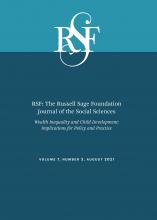Abstract
This article examines the link between wealth inequality and families’ financial investment, saving, and borrowing for the sake of children. Using the 1998–2016 Survey of Consumer Finances data, we show that American families have increasingly engaged in financially more intensive parenting but that there are substantial differences by wealth and race-ethnicity. Over time, White families above median wealth accumulate more financial assets and education savings as well as less education debt for children. In contrast, Black and Hispanic families across the wealth distribution have low financial assets and education savings for children. In addition, for Black families across the wealth distribution education debt has grown to substantial amounts. These findings suggest that the contemporary norm of intensive parenting has unequal financial manifestations, which have likely contributed to the widening of wealth and racial inequalities, especially between White and Black child households.
- © 2021 Russell Sage Foundation. Bandelj, Nina, and Angelina Grigoryeva. 2021. “Investment, Saving, and Borrowing for Children: Trends by Wealth, Race, and Ethnicity, 1998–2016.” RSF: The Russell Sage Foundation Journal of the Social Sciences 7(3): 50–77. DOI: 10.7758/RSF.2021.7.3.03. Direct correspondence to: Nina Bandelj at nina.bandelj{at}uci.edu, 3151 Social Sciences Plaza, University of California-Irvine, Irvine, CA 92617, United States; and Angelina Grigoryeva at angelina.grigoryeva{at}utoronto.ca.
Open Access Policy: RSF: The Russell Sage Foundation Journal of the Social Sciences is an open access journal. This article is published under a Creative Commons Attribution-NonCommercial-NoDerivs 3.0 Unported License.






